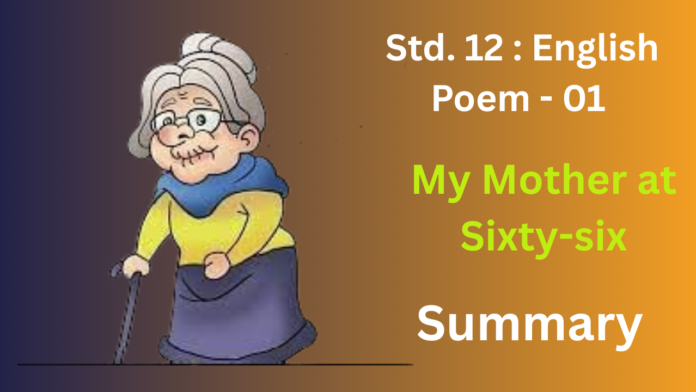The poem begins with the speaker traveling in a car beside her mother, who is dozing with her mouth open, her face pale and ashen, resembling a corpse. This sight fills the speaker with a sudden pang of fear and the realization of her mother’s approaching death.
To distract herself from these painful thoughts, the speaker looks out of the window at the vibrant and youthful imagery of speeding trees and children spilling out of their homes. This contrast between the vitality of the outside world and her mother’s frail state intensifies her feelings of unease and the fear of separation.
The speaker then arrives at the airport and goes through the security check. While standing a few yards away, she looks at her mother again. Her mother’s pale and withered face is likened to a “late winter’s moon,” a simile that evokes a sense of fading and fragility. The familiar ache of childhood fear – the fear of losing her mother – returns.
Despite the pain and worry, the speaker puts on a brave face. She bids her mother farewell with a smile and the hopeful words, “see you soon, Amma,” while concealing her anxiety. The poem ends with this seemingly optimistic yet emotionally charged farewell, leaving the reader with a sense of the daughter’s underlying sadness and the universal fear of a parent’s mortality.
In essence, the poem captures a fleeting moment of intense emotional realization about the mother’s age and the inevitable separation, highlighting the daughter’s love, fear, and the attempt to mask her vulnerability with a hopeful facade.
Exercise
Think it out
1. What is the kind of pain and ache that the poet feels?
Ans :
It’s a familiar, almost childhood fear resurfacing in adulthood as she witnesses the physical signs of her mother’s frailty.
She experiences the emotional pain of witnessing a loved one decline, coupled with the ache of a potential future without her mother’s presence. The contrast between her mother’s pale, fading appearance and the vibrant youth outside the car intensifies this painful awareness.
2. Why are the young trees described as ‘sprinting’?
Ans:
As the vehicle speeds along the road, the stationary trees outside appear to be rushing past in the opposite direction, creating the illusion of them “sprinting.”
This description also serves as a deliberate contrast to the image of the poet’s aging mother, who is described as dozing and ashen, symbolizing stillness and the slowing down associated with age and approaching death. The “sprinting” trees represent youth, vitality, and the quick passage of time, further highlighting the mother’s frailty and the inevitable progression towards the end of life.The juxtaposition emphasizes the poignant reality of aging against the backdrop of a world that continues to move swiftly forward.
3. Why has the poet brought in the image of the merry children ‘spilling out of their homes’?
Ans:
The poet brings in the image of the merry children ‘spilling out of their homes’ to create a stark contrast with the aging and passive image of her mother. The children represent youth, vitality, energy, and the joy of life bursting forth. Their “spilling out” suggests an abundance of life and activity. This vibrant imagery serves to further highlight the mother’s frailness, stillness, and the sense of life fading away from her. The juxtaposition emphasizes the cycle of life and the inevitable progression of aging, making the poet’s underlying fear of loss even more poignant. It’s a fleeting glimpse of youthful exuberance set against the backdrop of approaching mortality.
4. Why has the mother been compared to the ‘late winter’s moon’?
Ans :
The mother is like the ‘late winter’s moon’ because she looks pale and weak, signifying her aging and nearing death, just as the dim winter moon precedes the end of the season.
5. What do the parting words of the poet and her smile signify?
Ans:
While her words express a hopeful expectation of future reunion, the smile is a deliberate attempt to mask her underlying fear and pain of separation and her anxiety about her mother’s frail health. It’s a brave facade, a conscious effort to reassure her mother and perhaps even herself, preventing the raw emotion of their parting from being overtly displayed. The smile is thus a poignant symbol of love and concern, a way of conveying strength and optimism in the face of a deeply felt apprehension about the future and her mother’s well-being. It’s a bittersweet gesture, hiding worry beneath a veneer of cheerful hope.


